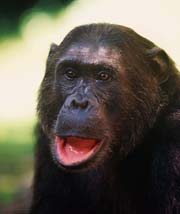Wyższe naczelne
| Haplorhini | |||
| Pocock, 1918[1] | |||
 Szympans | |||
| Systematyka | |||
| Domena | |||
|---|---|---|---|
| Królestwo | |||
| Typ | |||
| Podtyp | |||
| Gromada | |||
| Infragromada | |||
| Rząd | |||
| Podrząd |
wyższe naczelne | ||
| Infrarzędy | |||
| |||
Wyższe naczelne[2] (Haplorhini) – podrząd ssaków z rzędu naczelnych (Primates) obejmujący wyraki oraz małpokształtne, czyli szerokonose małpy Nowego Świata, wąskonose małpy Starego Świata i małpy człekokształtne. W języku polskim Haplorrhini określane są jako wyższe naczelne w odróżnieniu do niższych naczelnych z kladu lemurowych (Strepsirrhini). Haplorrhini jest taksonem monofiletycznym.
Wyższe naczelne mają pysk krótszy niż u przedstawicieli Strepsirrhini. Nozdrza nie są połączone z górną wargą. W oku występuje, nieobecny u niższych naczelnych, dołek środkowy siatkówki oka (fovea centralis), nie ma natomiast grzebienia zębowego i błony odblaskowej (tapetum lucidum). Większość prowadzi dzienny tryb życia – wyjątek stanowią ponocnice. Samice rodzą zwykle jedno młode, które przez długi czas jest zależne od matki.
Systematyka
Etymologia
Podział systematyczny
Do podrzędu należą następujące współcześnie występujące infrarzędy[2][5][6][7]:
- Tarsiiformes Gregory, 1915 – wyrakokształtne
- Simiiformes Haeckel, 1866 – małpokształtne
| Haplorrhini |
| ||||||||||||||||||
Opisano również infrarząd wymarły[8]:
- Eosimiiformes Chaimanee, Chavasseau, Beard, Aung Aung Khyaw, Aung Naing Soe, Chit Sein, Lazzari, Marivaux, Marandat, Myat Swe, Rugbumrung, Thit Lwin, Valentin, Zin Maung Maung Thein & Jaeger, 2012
Rodzaje wymarłe o niepewnej pozycji systematycznej i nie sklasyfikowane w żadnym z powyższych infrarzędów:
- Amamria Marivaux, Essid, Marzougui, Khayati Ammar, Adnet, Marandat, Merzeraud, Ramdarshan, Tabuce, Vianey-Liaud & Yans, 2014[9] – jednym przedstawicielem był Amamria tunisiensis Marivaux, Essid, Marzougui, Khayati Ammar, Adnet, Marandat, Merzeraud, Ramdarshan, Tabuce, Vianey-Liaud & Yans, 2014
- Aseanpithecus Jaeger, Chavasseau, Lazzari, Aung Naing Soe, Chit Sein, Le Maître, Hla Shwe & Chaimanee, 2019[10] – jednym przedstawicielem był Aseanpithecus myanmarensis Jaeger, Chavasseau, Lazzari, Aung Naing Soe, Chit Sein, Le Maître, Hla Shwe & Chaimanee, 2019
- Bugtipithecus Marivaux, Antoine, Baqri, Benammi, Chaimanee, Crochet, Franceschi, Iqbal, Jaeger, Métais, Roohi & Welcomme, 2005[11] – jednym przedstawicielem był Bugtipithecus inexpectans Marivaux, Antoine, Baqri, Benammi, Chaimanee, Crochet, Franceschi, Iqbal, Jaeger, Métais, Roohi & Welcomme, 2005
Przypisy
- ↑ R.I. Pocock. On the External Characters of the Lemurs and of Tarsius. „Proceedings of the Zoological Society of London”. 1918 (1), s. 1918, 53. (ang.).
- ↑ a b Nazwy zwyczajowe za: W. Cichocki, A. Ważna, J. Cichocki, E. Rajska-Jurgiel, A. Jasiński & W. Bogdanowicz: Polskie nazewnictwo ssaków świata. Warszawa: Muzeum i Instytut Zoologii PAN, 2015, s. 35. ISBN 978-83-88147-15-9. (pol. • ang.).
- ↑ Jaeger 1959 ↓, s. 116.
- ↑ Jaeger 1959 ↓, s. 221.
- ↑ N. Upham, C. Burgin, J. Widness, M. Becker, C. Parker, S. Liphardt, I. Rochon & D. Huckaby: Treeview of Mammalian Taxonomy Hierarchy. [w:] ASM Mammal Diversity Database (Version 1.11) [on-line]. American Society of Mammalogists. [dostęp 2023-09-10]. (ang.).
- ↑ C.J. Burgin: Introduction. W: Lynx Nature Books: All the Mammals of the World. Barcelona: Lynx Edicions, 2023, s. 22. ISBN 978-84-16728-66-4. (ang.).
- ↑ C.J. Burgin, D.E. Wilson, R.A. Mittermeier, A.B. Rylands, T.E. Lacher & W. Sechrest: Illustrated Checklist of the Mammals of the World. Cz. 1: Monotremata to Rodentia. Barcelona: Lynx Edicions, 2020, s. 26. ISBN 978-84-16728-34-3. (ang.).
- ↑ Y. Chaimanee,, O. Chavasseau, K.Ch. Beard, Aung Aung Khyaw, Aung Naing Soe, Chit Sein, V. Lazzari, L. Marivaux, B. Marandat, Myat Swe, M. Rugbumrung, Thit Lwin, X. Valentin, Zin Maung Maung Thein & J.-J. Jaeger. Late Middle Eocene primate from Myanmar and the initial anthropoid colonization of Africa. „Proceedings of the National Academy of Sciences”. 109 (26), s. 10294, 2012. DOI: 10.1073/pnas.1200644109. (ang.).
- ↑ L. Marivaux,, E.M. Essid, W. Marzougui, H. Khayati Ammar, S. Adnet, B. Marandat, G. Merzeraud, A. Ramdarshan, R. Tabuce, M. Vianey-Liaud & J. Yans. A morphological intermediate between eosimiiform and simiiform primates from the late middle Eocene of Tunisia: Macroevolutionary and paleobiogeographic implications of early anthropoids. „American Journal of Physical Anthropology”. 154 (3), s. 390, 2014. DOI: 10.1002/ajpa.22523. (ang.).
- ↑ J.-J. Jaeger, O. Chavasseau, V. Lazzari, Aung Naing Soe, Chit Sein, A. Le Maître, Hla Shwe & Y. Chaimanee. New Eocene primate from Myanmar shares dental characters with African Eocene crown anthropoids. „Nature Communications”. 10 (1), s. 1, 2019. DOI: 10.1038/s41467-019-11295-6. (ang.).
- ↑ L. Marivaux, P. Antoine, S.R.H. Baqri, M. Benammi, Y. Chaimanee, J. Crochet, D. de Franceschi, N. Iqbal, J.-J, Jaeger, G. Métais, G. Roohi & J.-L. Welcomme. Anthropoid primates from the Oligocene of Pakistan (Bugti Hills): Data on early anthropoid evolution and biogeography. „Proceedings of the National Academy of Sciences”. 102 (24), s. 8436, 2005. DOI: 10.1073/pnas.0503469102. (ang.).
Bibliografia
- E.C. Jaeger: Source-book of biological names and terms. Wyd. 3 (Revised second printing). Springfield: Charles C. Thomas, 1959, s. 1–316. (ang.).
- Zwierzęta : encyklopedia ilustrowana. Warszawa: Wydawnictwo Naukowe PWN, 2005. ISBN 83-01-14344-4.
- Wilson Don E. & Reeder DeeAnn M. (red.) Haplorrhini. w: Mammal Species of the World. A Taxonomic and Geographic Reference (Wyd. 3.) [on-line]. Johns Hopkins University Press, 2005. (ang.) [dostęp 27 grudnia 2008]
